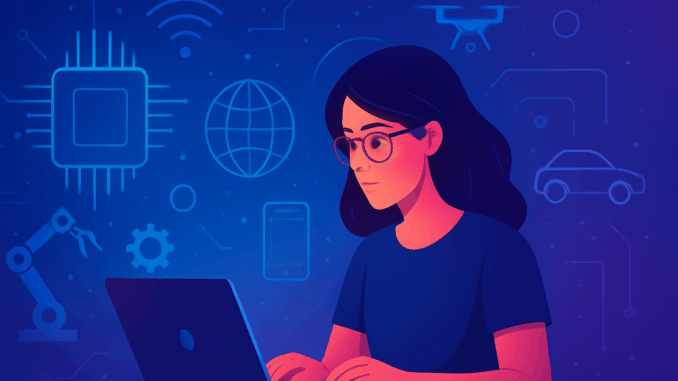
Smart Innovations: The Cutting-Edge Tech Trends Shaping Our Future
Introduction: A Future Defined by Innovation
The pace of technological innovation has never been faster. Every day, new advancements emerge that challenge our understanding of what’s possible, from intelligent machines and self-learning software to sustainable energy systems and life-changing healthcare solutions. These “smart innovations” are not just tools—they are the foundation of a new era, where technology integrates seamlessly into our daily lives and drives progress in every field.
As we stand at the edge of this digital transformation, understanding the key tech trends shaping our future can help us prepare for the opportunities and challenges ahead. From artificial intelligence to quantum computing and biotechnology, the innovations of today are building the smarter, more connected world of tomorrow.
1. Artificial Intelligence (AI): The Brain Behind the Machines
Artificial Intelligence continues to be at the heart of modern innovation. Once confined to research labs, AI is now integrated into almost every aspect of life. From voice assistants like Alexa and Siri to complex predictive analytics systems used by global corporations, AI is revolutionizing how we interact with technology.
The latest developments in Generative AI—tools capable of creating text, images, music, and even code—are expanding creativity and productivity across industries. Businesses are using AI to automate customer support, streamline logistics, and personalize marketing. In healthcare, AI-driven diagnostic systems can analyze scans and detect diseases more accurately than traditional methods.
Moreover, the rise of ethical AI aims to ensure transparency and fairness, addressing concerns around data privacy and bias. As AI becomes more advanced, its role will shift from mere automation to collaboration—working alongside humans to solve complex global problems.
2. The Internet of Things (IoT): A World of Connected Intelligence
The Internet of Things (IoT) refers to a network of interconnected devices that collect and share data to make smarter decisions. These devices—ranging from wearable fitness trackers to industrial sensors—are transforming the way we live, work, and manage resources.
In homes, IoT powers smart thermostats, lighting systems, and security cameras that can be controlled remotely via smartphones. In cities, IoT helps manage traffic flow, monitor pollution levels, and optimize waste management. This concept of smart cities aims to improve urban living through data-driven infrastructure.
Industries benefit as well. IoT-enabled factories use predictive maintenance to reduce downtime, while agriculture relies on connected sensors to monitor soil conditions and irrigation. As 5G connectivity expands, the potential of IoT will grow exponentially, enabling even faster communication between billions of smart devices.
3. Quantum Computing: Powering the Impossible
While traditional computers process data in binary form (0s and 1s), quantum computers use qubits, which can exist in multiple states simultaneously. This allows them to solve problems that are currently impossible for classical systems.
Quantum computing holds enormous promise in fields such as cryptography, pharmaceuticals, finance, and climate modeling. For example, it can simulate molecular structures to speed up drug discovery or optimize global logistics networks to reduce emissions and costs.
Although still in its early stages, major tech companies like IBM, Google, and Intel are making significant progress in quantum research. Once quantum computing becomes commercially viable, it could transform industries and redefine the limits of computational power.
4. 5G and Beyond: The Backbone of a Connected World
5G technology is not just an upgrade from 4G—it’s a complete reinvention of wireless communication. Offering ultra-fast speeds, low latency, and massive data capacity, 5G enables innovations like autonomous vehicles, remote surgery, and immersive virtual experiences.
For consumers, 5G means faster downloads, smoother streaming, and improved connectivity in crowded areas. But the real potential lies in how it supports other technologies. For instance, IoT devices rely on fast, stable connections to operate effectively, while augmented and virtual reality experiences become more seamless with reduced lag.
Looking ahead, 6G networks are already being researched, promising speeds up to 100 times faster than 5G. This next-generation connectivity will further blur the boundaries between the digital and physical worlds.
5. Extended Reality (XR): The New Dimension of Experience
Extended Reality (XR) is an umbrella term that covers Virtual Reality (VR), Augmented Reality (AR), and Mixed Reality (MR)—technologies that merge digital elements with the real world.
In entertainment, VR immerses users in virtual environments for gaming, storytelling, and exploration. AR, on the other hand, overlays digital information onto the physical world—used in apps like Pokémon Go or for navigation and education. Mixed Reality combines both, allowing users to interact with real and virtual objects simultaneously.
Businesses are leveraging XR for remote collaboration, virtual product demos, and employee training. For example, architects use VR to visualize designs before construction, while surgeons practice operations in realistic simulations. As XR becomes more accessible, it’s expected to transform not just entertainment but also education, retail, and healthcare.
6. Biotechnology and Health Tech: Redefining Human Potential
Advancements in biotechnology and digital health are reshaping medicine and human biology. Technologies like CRISPR gene editing, 3D bioprinting, and AI-powered diagnostics are pushing the boundaries of what’s possible in healthcare.
Wearable devices and smart sensors now track everything from heart rate to blood oxygen levels, helping individuals take control of their wellness. Telemedicine has made healthcare accessible to people in remote regions, while robotic-assisted surgery enhances precision and recovery outcomes.
Meanwhile, researchers are exploring ways to use biotechnology for sustainability—such as lab-grown meat, biofuels, and biodegradable materials. These innovations not only enhance quality of life but also support the global effort to protect the planet.
7. Green Technology: Smart Solutions for a Sustainable Future
As climate change becomes one of the greatest global challenges, green technology (or “cleantech”) is taking center stage. From renewable energy innovations to smart waste management, technology is key to achieving sustainability goals.
Solar panels, wind turbines, and energy storage systems are becoming more efficient and affordable. Smart grids use AI and IoT to balance energy demand and supply, reducing waste. In transportation, electric vehicles (EVs) and hydrogen-powered engines are cutting emissions and redefining mobility.
Even buildings are becoming “smart,” using sensors to control lighting and temperature, saving energy while enhancing comfort. By combining sustainability with digital innovation, green tech represents one of the most promising paths toward a cleaner, smarter future.
8. Robotics and Automation: The Future Workforce
Automation and robotics are changing how we work and produce goods. From warehouse robots to drones and self-driving cars, machines are becoming more capable, flexible, and intelligent.
In manufacturing, cobots (collaborative robots) work alongside humans to perform repetitive or dangerous tasks. In logistics, drones deliver packages and monitor supply chains in real time. Even in customer service, humanoid robots are being deployed to provide assistance in stores and hotels.
While automation raises questions about job displacement, it also creates new opportunities in design, programming, and maintenance. The future of work will likely involve a human-machine collaboration, where technology enhances human potential rather than replacing it.
9. Cybersecurity and Privacy: Protecting the Digital Frontier
As the world becomes more connected, the importance of cybersecurity grows. Cyberattacks, data breaches, and identity theft are increasing as more personal and financial information moves online.
To address these challenges, cybersecurity is evolving with innovations like AI-driven threat detection, biometric authentication, and blockchain-based security systems. Governments and organizations are investing heavily in cyber resilience to safeguard digital infrastructure.
For individuals, digital literacy and data protection practices—such as strong passwords, encryption, and privacy settings—are essential for navigating the online world safely. Cybersecurity will continue to be a major focus as technology integrates deeper into our lives.
10. The Ethical Side of Smart Innovation
With great innovation comes great responsibility. As powerful technologies like AI, biotechnology, and automation advance, ethical concerns about privacy, surveillance, and bias are increasingly relevant.
Developing responsible technology requires transparency, accountability, and inclusivity. Companies must ensure that innovation serves humanity as a whole, not just a select few. Governments, educators, and individuals all have a role to play in shaping ethical digital ecosystems that balance progress with protection.
Conclusion: A Smarter Tomorrow
The world is entering an age defined by intelligence—smart systems, smart cities, and smart living. The innovations transforming our present will soon become the foundation of a new era, where technology and humanity coexist in harmony.
From AI and IoT to green technology and quantum computing, the cutting-edge trends shaping our future are not just about faster machines or advanced algorithms—they’re about creating a better, more sustainable, and more connected world.
As we embrace these smart innovations, one thing is clear: the future isn’t just coming—it’s already here, powered by human creativity, driven by technology, and designed for a smarter tomorrow.

